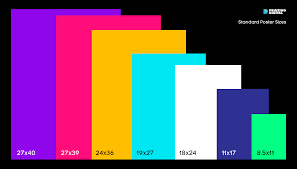Poster Size and Format Guide: Picking the Right Poster Size – Standard vs. Custom Sizes
Why Poster Size Matters
Choosing the right poster size can make a significant impact on its effectiveness. Whether you’re creating posters for advertising, decoration, or events, the size and format will determine readability, visual appeal, and placement suitability. With so many options available, knowing the difference between standard and custom sizes is essential for a successful design.
Standard Poster Sizes and Their Uses
Standard poster sizes vary depending on the country and industry, but they generally fall into these categories:
- Small Posters (11″ x 17″) – Ideal for indoor advertising, bulletin boards, or compact displays.
- Medium Posters (18″ x 24″) – A great choice for store promotions, trade shows, and educational posters.
- Large Posters (24″ x 36″) – Commonly used for movie posters, event promotions, and large-scale advertisements.
- Extra-Large Posters (27″ x 40″ and above) – Best for maximum visibility in outdoor advertising, subway stations, or high-traffic areas.
Opting for standard sizes can save massive time with a printable poster maker, as many templates are pre-designed to fit these dimensions.
Custom Poster Sizes: When and Why to Use Them
While standard sizes are convenient and cost-effective, there are cases where a custom size is the better option:
- Unique Branding Needs – If you’re creating a poster for a niche product or a special event, a distinctive size can make it stand out.
- Specific Display Requirements – Some locations have size constraints, such as store windows, exhibition booths, or trade show panels.
- High-Impact Designs – Custom-sized posters allow for creative freedom, making room for innovative layouts, larger fonts, or unique aspect ratios.
Choosing the Right Poster Format
Beyond size, the format of a poster also plays a crucial role in its effectiveness:
- Portrait vs. Landscape – Portrait is traditional and works well for most designs, while landscape can be more eye-catching in specific settings, like wide storefronts or conference displays.
- Digital vs. Print – If you plan to use your design for both physical and online promotions, ensure it’s optimized for multiple formats.
- Paper Type and Finish – Glossy prints enhance color vibrancy, while matte finishes reduce glare, making text easier to read under bright lights.
Final Tips for Picking the Perfect Poster Size
- Consider Your Audience and Viewing Distance – A smaller poster works well for close-up reading, while larger posters need to be legible from afar.
- Check Printing Costs – Larger sizes and custom dimensions may cost more, so balance impact with budget.
- Test Your Design – Print a smaller version first to check readability and visual appeal before finalizing the size.
By understanding poster sizes and formats, you can create visually compelling designs that effectively convey your message. Whether choosing a standard size for convenience or a custom size for uniqueness, the right dimensions will ensure your poster stands out in any setting.







